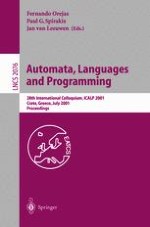2001 | OriginalPaper | Chapter
Lower Bounds in the Quantum Cell Probe Model
Authors : Pranab Sen, S. Venkatesh
Published in: Automata, Languages and Programming
Publisher: Springer Berlin Heidelberg
Included in: Professional Book Archive
Activate our intelligent search to find suitable subject content or patents.
Select sections of text to find matching patents with Artificial Intelligence. powered by
Select sections of text to find additional relevant content using AI-assisted search. powered by
We introduce a new model for studying quantum data structure problems — the quantum cell probe model. We prove a lower bound for the static predecessor problem in the address-only version of this model where, essentially, we allow quantum parallelism only over the ‘address lines’ of the queries. This model subsumes the classical cell probe model, and many quantum query algorithms like Grover’s algorithm fall into this framework. We prove our lower bound by obtaining a round elimination lemma for quantum communication complexity. A similar lemma was proved by Miltersen, Nisan, Safra and Wigderson [9] for classical communication complexity, but their proof does not generalise to the quantum setting.We also study the static membership problem in the quantum cell probe model. Generalising a result of Yao [16], we show that if the storage scheme is implicit, that is it can only store members of the subset and ‘pointers’, then any quantum query scheme must make Ω(log n) probes. We also consider the one-round quantum communication complexity of set membership and show tight bounds.
